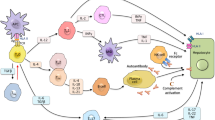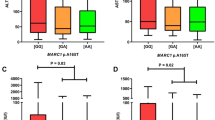Abstract
We have previously reported a strong association between HLA-DRB1*1301 and type 1 pediatric autoimmune hepatitis (PAH) and between HLA-DR*0405 and adult autoimmune hepatitis (AAH). Because human killer cell immunoglobulin-like receptors are known to be associated with susceptibility to autoimmune diseases, we investigated the frequencies of HLA-A, B, C, DRB1 and KIR genes in 144 type 1 PAH and 86 AAH patients, which were compared with 273 healthy controls. We demonstrated in PAH the increased frequency of the functional form of KIR2DS4-Full Length (KIR2DS4-FL), which in combination with HLA-DRB1*1301 revealed a strong synergistic effect (odds ratio=36.5). PAH-KIR2DS4-FL+ subjects have shown an increased frequency of their putative HLA-C*02, 04 and 06 ligands. KIR analysis of PAH also revealed a decreased frequency of KIR2DL2 gene and its ligand. In contrast, AAH cases have shown a weaker increased frequency of KIR2DS4-FL, a lack of synergistic effect with HLA class II antigens and a moderate association with HLA-DRB1*0405. Of note, we demonstrated that liver T cells have a unique pattern of KIR expression. These results show a KIR gene involved in autoimmune hepatitis and suggest a stronger genetic influence for the early onset type I autoimmune hepatitis.
This is a preview of subscription content, access via your institution
Access options
Subscribe to this journal
Receive 6 digital issues and online access to articles
$119.00 per year
only $19.83 per issue
Buy this article
- Purchase on Springer Link
- Instant access to full article PDF
Prices may be subject to local taxes which are calculated during checkout

Similar content being viewed by others
References
Mackay IR . Immunological aspects of chronic active hepatitis. Hepatology 1983; 3: 724–728.
Czaja AJ . Natural history, clinical features, and treatment of autoimmune hepatitis. Semin Liver Dis 1984; 4: 1–12.
Johnson PJ, McFarlane IG . Meeting report: International Autoimmune Hepatitis Group. Hepatology 1993; 18: 998–1005.
Fainboim L, Marcos Y, Pando M, Capucchio M, Reyes GB, Galoppo C et al. Chronic active autoimmune hepatitis in children. Strong association with a particular HLA-DR6 (DRB1*1301) haplotype. Hum Immunol 1994; 41: 146–150.
Pando M, Larriba J, Fernandez GC, Fainboim H, Ciocca M, Ramonet M et al. Pediatric and adult forms of type I autoimmune hepatitis in Argentina: evidence for differential genetic predisposition. Hepatology 1999; 30: 1374–1380.
Bittencourt PL, Goldberg AC, Cancado EL, Porta G, Carrilho FJ, Farias AQ et al. Genetic heterogeneity in susceptibility to autoimmune hepatitis types 1 and 2. Am J Gastroenterol 1999; 94: 1906–1913.
Fortes Mdel P, Machado IV, Gil G, Fernandez-Mestre M, Dagher L, Leon RV et al. Genetic contribution of major histocompatibility complex class II region to type 1 autoimmune hepatitis susceptibility in Venezuela. Liver Int 2007; 27: 1409–1416.
Djilali-Saiah I, Renous R, Caillat-Zucman S, Debray D, Alvarez F . Linkage disequilibrium between HLA class II region and autoimmune hepatitis in pediatric patients. J Hepatol 2004; 40: 904–909.
Donaldson PT, Doherty DG, Hayllar KM, McFarlane IG, Johnson PJ, Williams R . Susceptibility to autoimmune chronic active hepatitis: human leukocyte antigens DR4 and A1-B8-DR3 are independent risk factors. Hepatology 1991; 13: 701–706.
Czaja AJ, Strettell MD, Thomson LJ, Santrach PJ, Moore SB, Donaldson PT et al. Associations between alleles of the major histocompatibility complex and type 1 autoimmune hepatitis. Hepatology 1997; 25: 317–323.
Marcos Y, Fainboim HA, Capucchio M, Findor J, Daruich J, Reyes B et al. Two-locus involvement in the association of human leukocyte antigen with the extrahepatic manifestations of autoimmune chronic active hepatitis. Hepatology 1994; 19: 1371–1374.
Seki T, Ota M, Furuta S, Fukushima H, Kondo T, Hino K et al. HLA class II molecules and autoimmune hepatitis susceptibility in Japanese patients. Gastroenterology 1992; 103: 1041–1047.
Kulkarni S, Martin MP, Carrington M . The Yin and Yang of HLA and KIR in human disease. Semin Immunol 2008; 20: 343–352.
Beziat V, Liu LL, Malmberg JA, Ivarsson MA, Sohlberg E, Bjorklund AT et al. NK cell responses to cytomegalovirus infection lead to stable imprints in the human KIR repertoire and involve activating KIRs. Blood 2013; 121: 2678–2688.
Khakoo SI, Rajalingam R, Shum BP, Weidenbach K, Flodin L, Muir DG et al. Rapid evolution of NK cell receptor systems demonstrated by comparison of chimpanzees and humans. Immunity 2000; 12: 687–698.
Flores AC, Marcos CY, Paladino N, Capucchio M, Theiler G, Arruvito L et al. KIR genes polymorphism in Argentinean Caucasoid and Amerindian populations. Tissue Antigens 2007; 69: 568–576.
Middleton D, Gonzalez A, Gilmore PM . Studies on the expression of the deleted KIR2DS4*003 gene product and distribution of KIR2DS4 deleted and nondeleted versions in different populations. Hum Immunol 2007; 68: 128–134.
Svejgaard A, Ryder LP . HLA and disease associations: detecting the strongest association. Tissue Antigens 1994; 43: 18–27.
Colonna M, Borsellino G, Falco M, Ferrara GB, Strominger JL . HLA-C is the inhibitory ligand that determines dominant resistance to lysis by NK1- and NK2-specific natural killer cells. Proc Natl Acad Sci USA 1993; 90: 12000–12004.
Wagtmann N, Rajagopalan S, Winter CC, Peruzzi M, Long EO . Killer cell inhibitory receptors specific for HLA-C and HLA-B identified by direct binding and by functional transfer. Immunity 1995; 3: 801–809.
Pende D, Marcenaro S, Falco M, Martini S, Bernardo ME, Montagna D et al. Anti-leukemia activity of alloreactive NK cells in KIR ligand-mismatched haploidentical HSCT for pediatric patients: evaluation of the functional role of activating KIR and redefinition of inhibitory KIR specificity. Blood 2009; 113: 3119–3129.
Schonberg K, Sribar M, Enczmann J, Fischer JC, Uhrberg M . Analyses of HLA-C-specific KIR repertoires in donors with group A and B haplotypes suggest a ligand-instructed model of NK cell receptor acquisition. Blood 2011; 117: 98–107.
Graef T, Moesta AK, Norman PJ, Abi-Rached L, Vago L, Older Aguilar AM et al. KIR2DS4 is a product of gene conversion with KIR3DL2 that introduced specificity for HLA-A*11 while diminishing avidity for HLA-C. J Exp Med 2009; 206: 2557–2572.
Pesce S, Carlomagno S, Moretta A, Sivori S, Marcenaro E . Uptake of CCR7 by KIR2DS4(+) NK Cells is induced upon recognition of certain HLA-C alleles. J Immunol Res 2015; 2015: 754373.
Holm SJ, Sakuraba K, Mallbris L, Wolk K, Stahle M, Sanchez FO . Distinct HLA-C/KIR genotype profile associates with guttate psoriasis. J Invest Dermatol 2005; 125: 721–730.
Luszczek W, Manczak M, Cislo M, Nockowski P, Wisniewski A, Jasek M et al. Gene for the activating natural killer cell receptor, KIR2DS1, is associated with susceptibility to psoriasis vulgaris. Hum Immunol 2004; 65: 758–766.
Williams F, Meenagh A, Sleator C, Cook D, Fernandez-Vina M, Bowcock AM et al. Activating killer cell immunoglobulin-like receptor gene KIR2DS1 is associated with psoriatic arthritis. Hum Immunol 2005; 66: 836–841.
Momot T, Koch S, Hunzelmann N, Krieg T, Ulbricht K, Schmidt RE et al. Association of killer cell immunoglobulin-like receptors with scleroderma. Arthritis Rheum 2004; 50: 1561–1565.
Yen JH, Moore BE, Nakajima T, Scholl D, Schaid DJ, Weyand CM et al. Major histocompatibility complex class I-recognizing receptors are disease risk genes in rheumatoid arthritis. J Exp Med 2001; 193: 1159–1167.
Majorczyk E, Pawlik A, Gendosz D, Kusnierczyk P . Presence of the full-length KIR2DS4 gene reduces the chance of rheumatoid arthritis patients to respond to methotrexate treatment. BMC Musculoskelet Disord 2014; 15: 256.
Legaz I, Lopez-Alvarez MR, Campillo JA, Moya-Quiles MR, Bolarin JM, de la Pena J et al. KIR gene mismatching and KIR/C ligands in liver transplantation: consequences for short-term liver allograft injury. Transplantation 2013; 95: 1037–1044.
Katz G, Gazit R, Arnon TI, Gonen-Gross T, Tarcic G, Markel G et al. MHC class I-independent recognition of NK-activating receptor KIR2DS4. J Immunol 2004; 173: 1819–1825.
Merino A, Malhotra R, Morton M, Mulenga J, Allen S, Hunter E et al. Impact of a functional KIR2DS4 allele on heterosexual HIV-1 transmission among discordant Zambian couples. J Infect Dis 2011; 203: 487–495.
Liberal R, Vergani D, Mieli-Vergani G . Update on autoimmune hepatitis. J Clin Transl Hepatol 2015; 3: 42–52.
Pillarisetty VG, Katz SC, Bleier JI, Shah AB, Dematteo RP . Natural killer dendritic cells have both antigen presenting and lytic function and in response to CpG produce IFN-gamma via autocrine IL-12. J Immunol 2005; 174: 2612–2618.
Czaja AJ, Carpenter HA . Sensitivity, specificity, and predictability of biopsy interpretations in chronic hepatitis. Gastroenterology 1993; 105: 1824–1832.
Kelly A, Fahey R, Fletcher JM, Keogh C, Carroll AG, Siddachari R et al. CD141(+) myeloid dendritic cells are enriched in healthy human liver. J Hepatol 2014; 60: 135–142.
Middleton D, Williams F, Halfpenny IA . KIR genes. Transpl Immunol 2005; 14: 135–142.
Maxwell LD, Williams F, Gilmore P, Meenagh A, Middleton D . Investigation of killer cell immunoglobulin-like receptor gene diversity: II. KIR2DS4. Hum Immunol 2004; 65: 613–621.
Cereb N, Maye P, Lee S, Kong Y, Yang SY . Locus-specific amplification of HLA class I genes from genomic DNA: locus-specific sequences in the first and third introns of HLA-A, -B, and -C alleles. Tissue Antigens 1995; 45: 1–11.
Acknowledgements
We thank Derek Middleton for his help with the initial genotyping of the KIR genes. This work was supported by research grants from ANPCYT PICT BICENTENARIO 2010 No. 0392, PICTO-GLAXO SMITH KLINE 2011 No. 0031 and Fundación de Asistencia Social del Hospital de Clínicas.
Author information
Authors and Affiliations
Corresponding author
Ethics declarations
Competing interests
The authors declare no conflict of interest.
Rights and permissions
About this article
Cite this article
Podhorzer, A., Paladino, N., Cuarterolo, M. et al. The early onset of type 1 autoimmune hepatitis has a strong genetic influence: role of HLA and KIR genes. Genes Immun 17, 187–192 (2016). https://doi.org/10.1038/gene.2016.7
Received:
Revised:
Accepted:
Published:
Issue Date:
DOI: https://doi.org/10.1038/gene.2016.7



